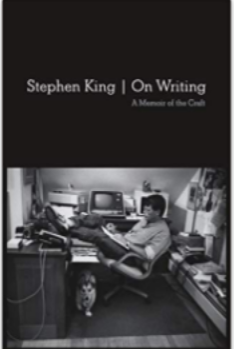
Stephen King’s On Writing: A Memoir of the Craft is more of a personal memoir than a treatise on writing. When you drill down into the book, however, you can obtain some great writing tips that you should keep in mind when working on your first draft. I’ve condensed some of the best tips for you here:
Write for yourself first, and worry about the audience later
I’ve heard this piece of advice from several authors. Write what you are passionate about, and people will be drawn to that. As Simon Sinek says in his presentation on Start With Why what you do is the proof of what you believe.
Further, don’t be afraid of offending people. As King says, “If you intend to write as truthfully as you can, your days as a member of polite society are numbered, anyway.” Write the truth.
In the past, I’ve been afraid of offending people or concerned that people won’t like what I write, but you know what? We don’t love every book we read, and that’s okay. There are people who will be drawn to your passion for what you write.
Do not use adverbs, especially after “said”
Or, rather, use them sparingly and strategically. E.g., instead of “she walked slowly,” try “she sauntered,” or “she lagged,” or “she dragged her feet.”
Even King agrees that it’s impossible to cut ALL adverbs. After all, he uses adverbs in his writing, too. You should cut them down, however.
Do not use passive voice
I’ve been guilty of this. Passive voice has its place, but people tend to overuse it. When you proofread, make sure that you proof specifically for passive voice.
Use “said” and simple variants thereof instead of fancier words for describing dialogue
This is an Elmore Leonard rule. Leonard was a fiction writer (Get Shorty is a fantastic read!), and I highly recommend that you read his stuff to see what good written dialogue looks like. One of his main rules was to use said instead of more elaborate verbs.
Show, don’t tell. Instead of “‘I know!” she said angrily,’ try “‘I know!”, she said, and threw her pen on the table with unnecessary force,” or, “‘I know!” she said as she stomped away.”
Do not write too much back story, certainly not at the beginning of the book
Give just enough. Indeed, the beginning of your story should serve as a hook for the reader; it should not be replete with superfluous description. Ask yourself whether a scene or subplot is integral to the overarching story line of your novel.
Take out the boring bits
This advice appears simple, but it’s not. In other words, take out all the stuff that you thought sounded cool but which really has nothing to do with the story. As King says, kill all the little darlings. That is, delete the unnecessary description and tangents that don’t move the story along.
I’ll elaborate on this a little. Don’t overexplain things. In his book, King provides good examples of edited prose, which weeds out the unnecessary parts.
Here’s an example from my first draft of Miscalculated Risks: “She ran as if she didn’t care about whether or not she tripped and fell, because in fact, she didn’t.” Huh? This is terrible! (Again, first draft LOL).
Instead: “she ran,” or “she bolted,” or “she sped,” or even “she flew like lightning.” Any of these are better than the sentence above, and they convey the same image and meaning to the reader. The reader doesn’t need you to overexplain (another of King’s main points). He says that often authors are too preoccupied with making sure that the reader understands what we’re trying to convey. Don’t worry about that so much, because the reader gets it. Someone who is speeding or bolting obviously doesn’t care too much about tripping and falling; otherwise, they would walk slowly, placing their steps carefully (there’s your well-placed adverb).
Start with the story first, then the plot will resolve itself
Writing fiction is about telling a good story (writing nonfiction is usually about helping the reader). Do not start first with the plot in mind. You’re telling a story about someone (or many people) overcoming an obstacle (this works in the romance genre too, where the couple typically has to surmount obstacles to get together). Don’t force the story. Instead, see where it takes you.
And for all those “little darlings” that you end up with when you’re done writing? Save them in a separate document and use them for flash fiction pieces, prologues, prequels, freebie stories for your mailing list, etc. They don’t necessarily need to go to waste just because they didn’t make it into your novel.
Read a TON in order to become a better writer
One of the things I didn’t really think about when I started writing was point of view. Even if the prose is third person, it’s told from someone’s point of view. Pay attention when you read and you’ll see when the author changes point of view. When you write, think about from whose point of view you are telling the story. If you change point of view, make sure that it is clear to the reader.
Here’s my addition to King’s list: You need to hook the reader in the beginning
There are SO many books on the market today, and people have shorter and shorter attention spans. You therefore need to grab the reader’s attention right away.
The first few paragraphs of your book need to hook the reader. As my son says, “Fishing is like writing because you need to have a good hook.” We’ve all read those books that we cannot put down, that we feel compelled to finish, leaving all other activities by the wayside.
Here’s a great example of an opening hook (from Ralph Cotton’s Ride to Hell’s Gate):
Lawrence Shaw, aka Fast Larry, aka the Fastest Gun Alive, aka the Mad Gunman, aka Chever Reed, had been too drunk for too long to be standing in a dirt street about to do battle. Yet here he stood, squinting through a whiskey haze.
The reader’s interest is piqued from the beginning. First, the book begins with a gun duel (always a good sign). Second, we find out a lot about Lawrence Shaw in just a few lines. He’s made some questionable choices in life, and he presumably deals in some nefarious activities. Why else would he have all those aliases? The reader is intrigued from the beginning.
And here’s an example from one of my forthcoming novels, a hook that my son really liked:
Sabrina stomped in to the old, worn-out building, her boots thumping on the creaky, wooden floor. There was dust everywhere. On a bad day, she loathed this place. On a good day, she still loathed it but remembered that it at least put food on her sons’ plates and a dilapidated roof over their heads.
Here, the reader is left wondering, why does Sabrina loathe this place? What’s her job?
There you have it. A few solid rules to get you started. Check out On Writing as your local retailer.
Email me on maria@lawschoolheretic.com if you have any questions.
Happy Writing!
Get helpful writing tips and more
in your inbox
Join the tribe and get free fiction and self-publishing tips.
Thank you for subscribing.
Something went wrong.

[…] last week’s post on Stephen King’s writing tips, I mentioned fiction author Elmore Leonard. Leonard was a prolific genre writer, including crime […]
[…] And I also told you that you need a good way of hooking the reader so that he keeps turning pages, and provided some examples of great first paragraphs. […]